
FS-2023-0702 | January 2024
UNIVERSITY OF MARYLAND EXTENSION AND MARYLAND SEA GRANT COLLEGE
Maryland Shellfish Aquaculture Industry: 2022 at a Glance
Report Highlights
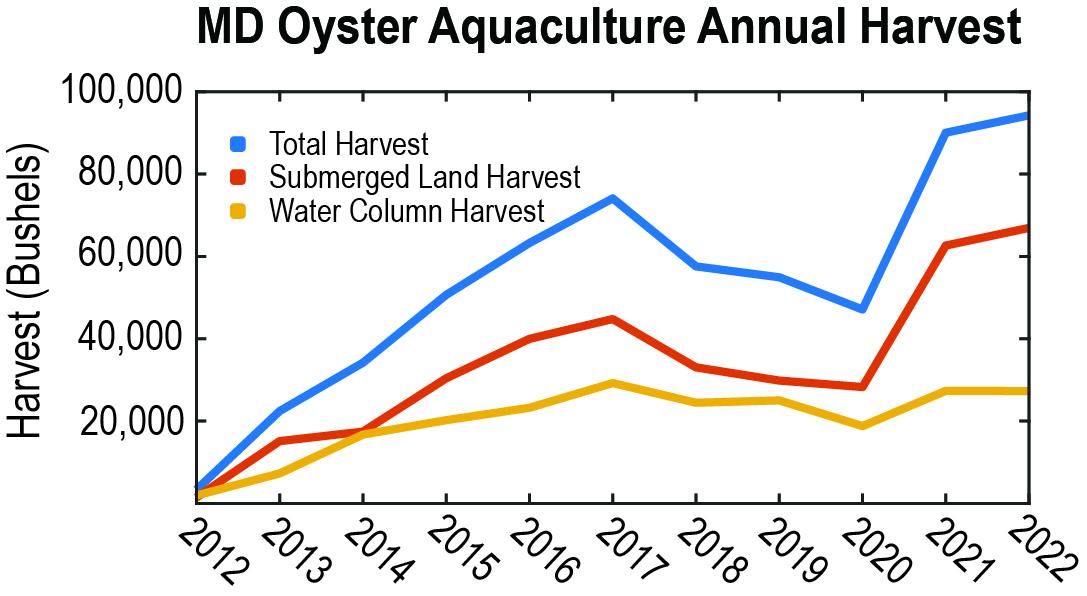
The Maryland oyster aquaculture industry reported a record harvest of 94,257 bushels in 2022, an increase of 4.5% from the previous record in 2021. Bay scallop harvest also increased by 39.9% compared to 2021. (The number and value of bay scallops harvested is not reported to maintain business privacy since there are fewer than three growers in the state.) The average price of single oysters dropped slightly while the average price for oysters sold as bushels increased. The estimated dockside value of the oyster aquaculture industry in Maryland for 2022 was $7,296,543. The Maryland Department of Natural Resources (MDNR) received 17 new aquaculture lease applications and issued 18 new leases in 2022 (Maryland Department of Natural Resources, 2023).
2022: Harvest Summary

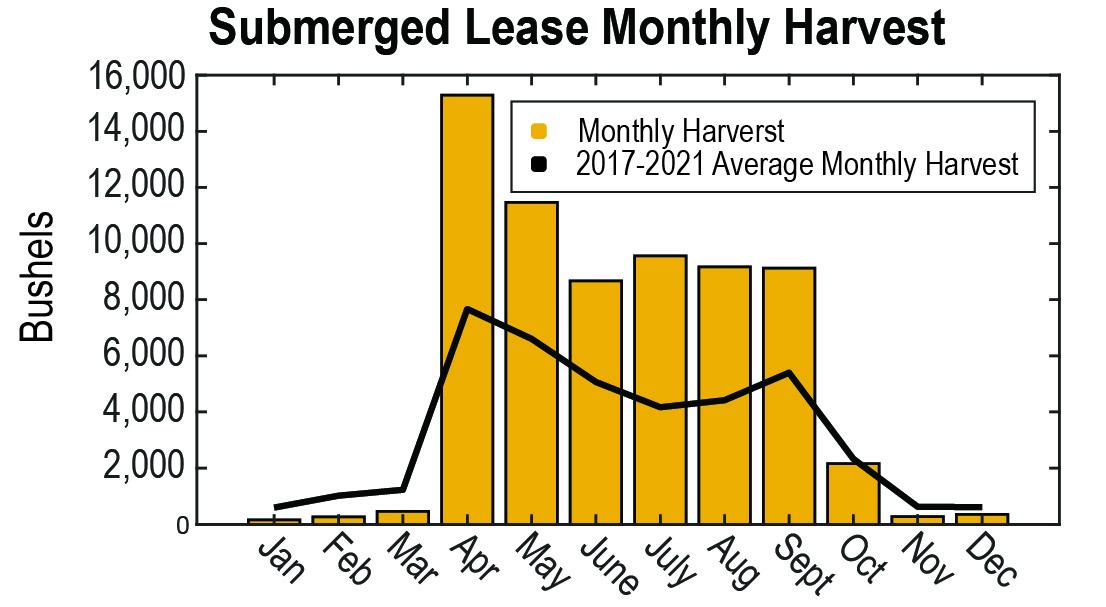
The 2022 Maryland oyster aquaculture harvest was the largest since the modern leasing program took effect. The 2022 harvest registered 94,257 bushels of oysters (Crassostrea virginica), with 66,946 bushels harvested from submerged land leases and 27,311 bushels from water-column leases (Figure 1). Submerged land lease oysters are grown on and harvested directly from suitably prepared bottom, while those grown on water-column leases use single animals placed in containerized gear (e.g., baskets, cages, bags, etc.), most commonly in cages that rest on the bottom or in surface floats. The 2022 farm-raised oyster harvest saw a 4% increase compared to 2021. The portion of the 2022 harvest reported from submerged land leases was the largest since the modern program took effect, while the 2022 water-column harvest decreased slightly from 2021 reports (Figure 1). The bulk of harvest from submerged land leases typically occurs from April 1 to September 30 when leaseholders can take advantage of higher prices and avoid competition with the wild oyster fishery harvest during public harvest months, while the water-column harvest is relatively consistent throughout the year (Figures 2 & 3).
Economic Impact of Oyster Aquaculture in Maryland
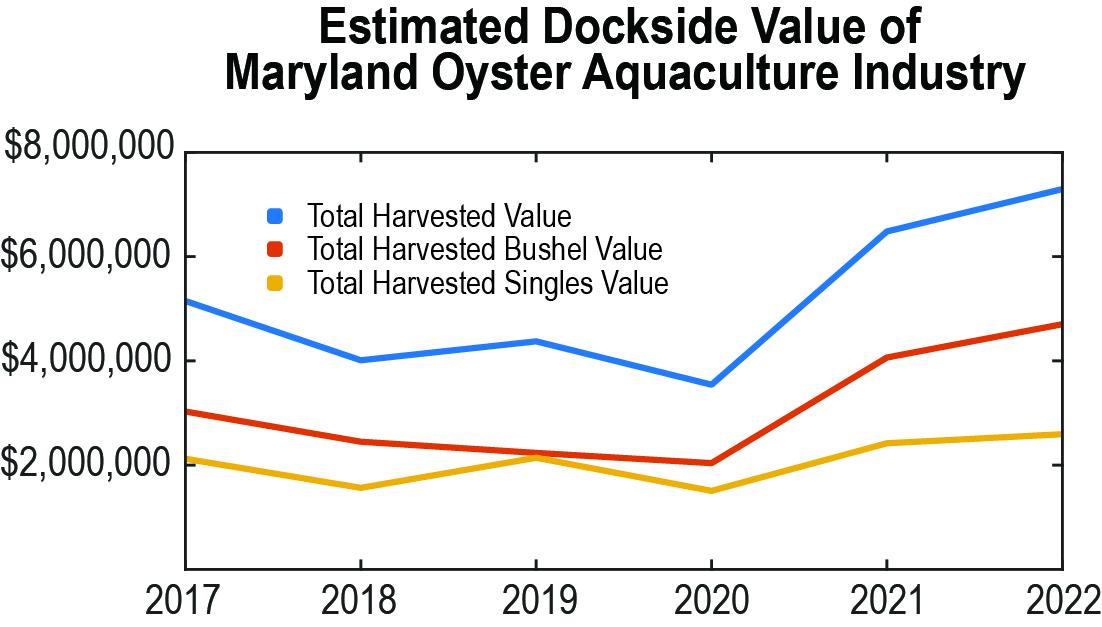
The increased harvest from leases in 2022 contributed to a record dockside value for farmed oysters since the modern leasing program took effect. In 2022, the estimated dockside value of aquaculture oysters in Maryland was $7,296,543. This is an increase of over $800,000 compared to the 2021 dockside value (Figure 4), driven in part by increased year-over-year harvest, but also by higher average per bushel and per piece retail and wholesale prices (Maryland Department of Natural Resources, 2023).
Aquaculture operations in Maryland sell oysters by the bushel or individually as single oysters (singles) to a variety of markets which may range from wholesalers to direct-to-consumer sales, each with different prices. The average reported dockside price for Maryland oysters sold by the bushel in 2022 increased to $62 per bushel. Previously, the average dockside price per bushel had remained steady at $55 since 2017. The average dockside price per Maryland oyster sold as singles was $0.40 per oyster in 2017 and 2018, then increased to $0.50 per oyster in 2019 where it remained through 2021. In 2022, the average reported dockside price for oysters sold as singles decreased to $0.47 per oyster. Note that average dockside prices are calculated via self-reported wholesale and retail real price averages from annual surveys returned to the MDNR.
As with previous years, the total value of oysters sold to bushel markets in Maryland in 2022 was higher than the total value sold as singles (Figure 4). The authors of this publication used the economic ratios published in van Senten (2020) to estimate the total economic impact of the oyster aquaculture industry on Maryland to be approximately $13.3 million in 2022.
Unique grower financing programs continue to play an important role in supporting the growth of the shellfish aquaculture industry in Maryland. Since its inception in 2010, the Maryland Agricultural Resource-Based Industry Development Corporation (MARBIDCO) has approved loans totaling over $5 million through the Maryland Shellfish Aquaculture Financing Fund (MSAFF) and the Maryland Shellfish Remote Setting Loan Fund (MSRSLF). MARBIDCO’s shellfish loan program features interest-only payment periods and principal forgiveness if certain conditions are met. In 2022, MARBIDCO approved four loan applications totaling $315,135 for the MSAFF and two applications totaling $30,000 for the MSRSLF (MARBIDCO, 2023).
Lease Data
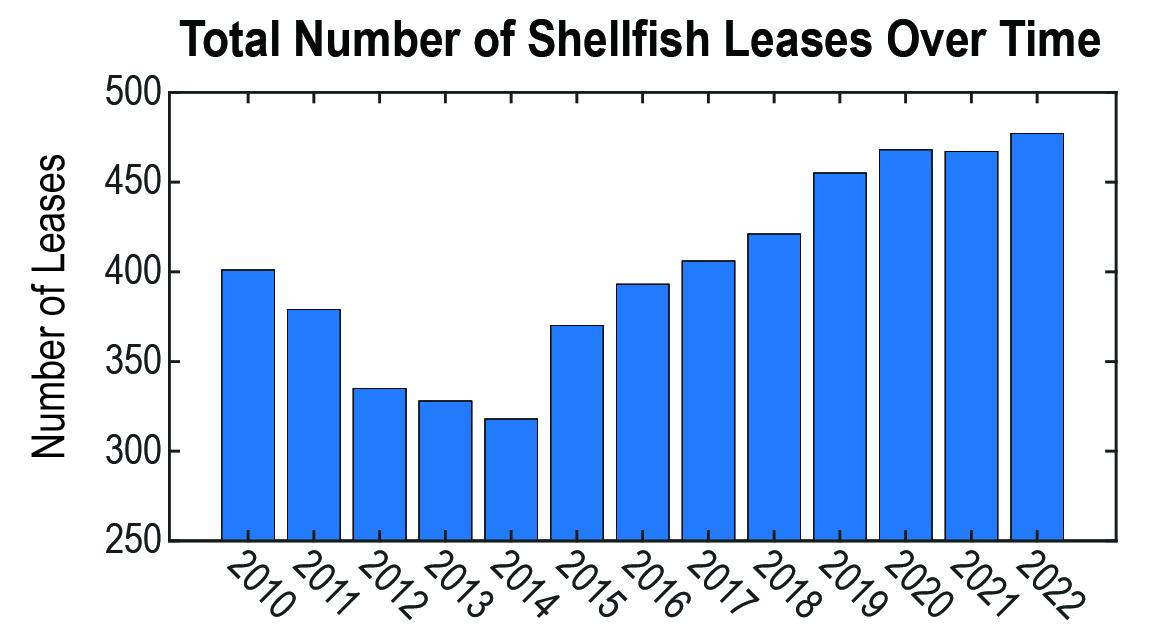
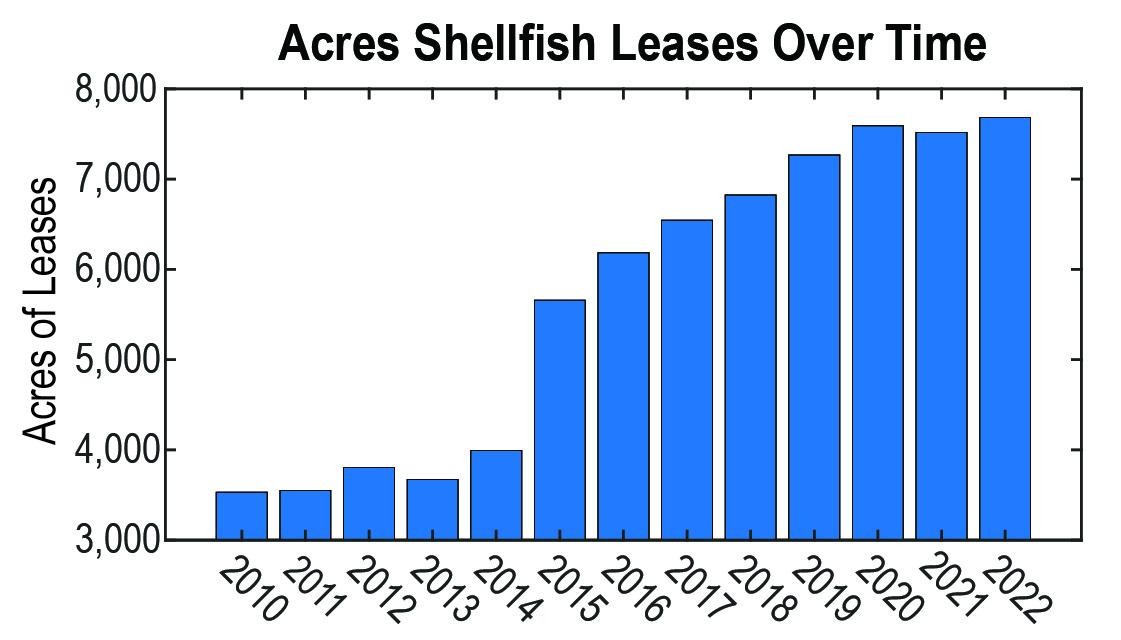
At the end of 2022, there were 477 shellfish leases comprising 7,685 acres of Maryland waterways. Submerged land leases accounted for 7,115 acres on 374 sites, while 103 water-column leases covered 568 acres (Figures 5 & 6) (Maryland Department of Natural Resources, 2022). These totals represent a slight increase from December 2021, when there were 467 shellfish leases on 7,518 acres (Maryland Department of Natural Resources, 2023). During the calendar year 2022, the MDNR received 17 new commercial shellfish lease applications and issued 18 new leases. At the end of 2022, 91 lease applications remained in process by MDNR (Maryland Department of Natural Resources, 2023). In many instances, an individual or business entity may hold more than one lease while operating as a single entity. In other cases, leases may be held in the names of distinct individuals but operate as a single business or partnership. The MDNR collects data on each lease through mandatory annual reporting to ensure “active use.” While MDNR does not formally collect data for the total number of aquaculture businesses, the number of distinct leaseholders has hovered between 165 and 175 since 2017. The number of distinct leaseholders can be used as a proxy to estimate the number of aquaculture businesses in Maryland.
Maryland shellfish leases were located in 11 counties in 2022 (Figure 7) (Maryland Department of Natural Resources, 2023). Many leaseholders hold multiple leases ranging in size from less than an acre to hundreds of acres. In Maryland, water-column leases are generally smaller than submerged land leases; at the end of 2022, the average water-column lease size was 5.5 acres and the average submerged land lease covered 19 acres.
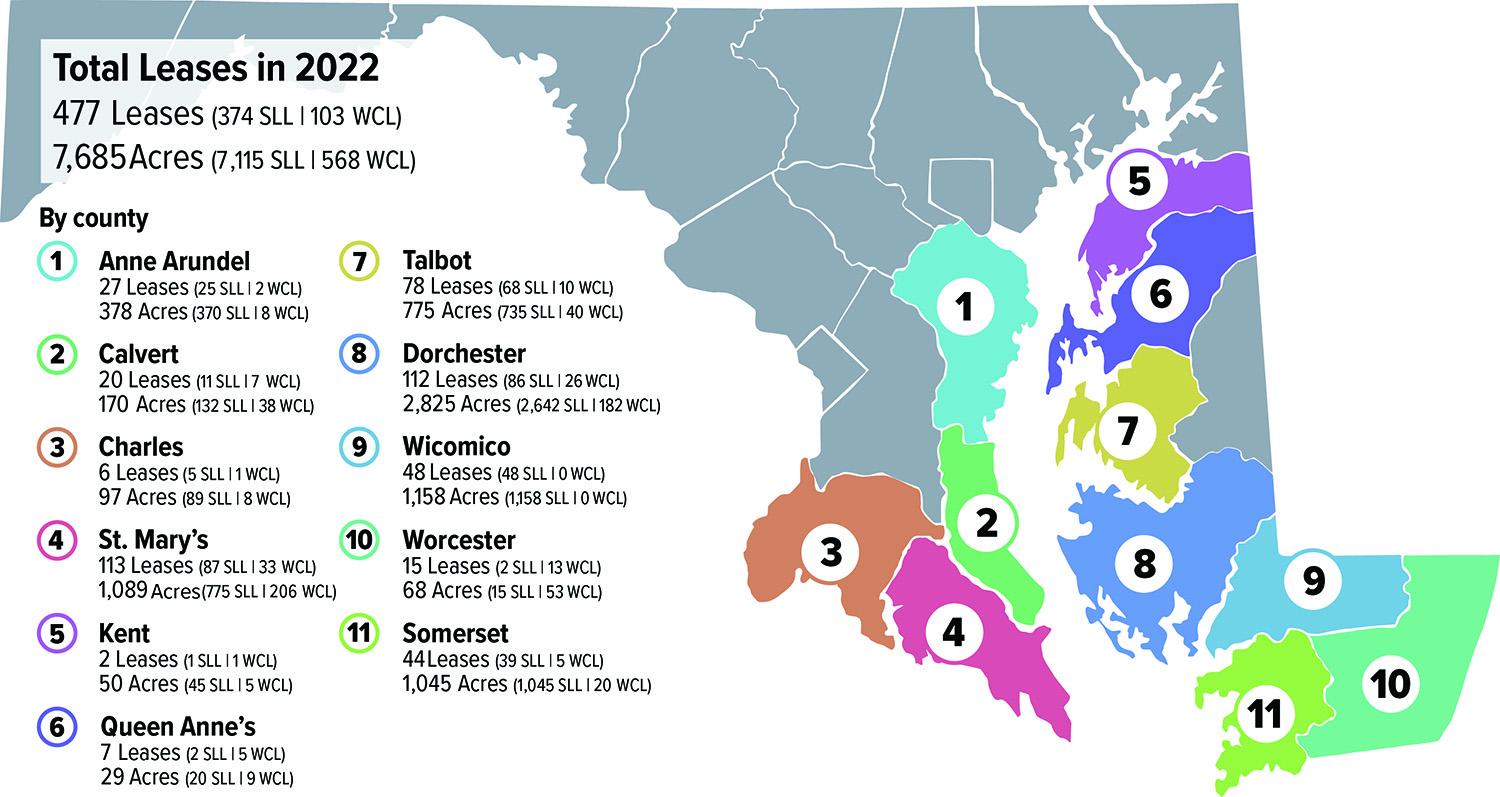
References
- Maryland Department of Natural Resources. 2022 and 2023. All lease, leaseholder, harvest, and dockside value data are provided courtesy of MDNR staff via email request from the authors.
- MARBIDCO. 2023. MARBIDCO loan information is provided courtesy of MARBIDCO staff via email request from the authors.
- van Senten, J., Engle, C, Parker, M, and Webster, D. (2020) Analysis of the economic benefits of the Maryland shellfish aquaculture industry. Chesapeake Bay Foundation. Annapolis, MD. 51pp.
University of Maryland Extension and Maryland Sea Grant Extension work to support sustainable fisheries and aquaculture in the state. For more information about shellfish aquaculture in Maryland, including resources for current and new growers, please visit extension.umd.edu/aquaculture, dnr.maryland.gov/fisheries/Pages/aquaculture/index.aspx, and go.umd.edu/OysterAquacultureDashboard
MATTHEW PARKER*
University of Maryland Extension
mparke11@umd.edu
DONALD WEBSTER
University of Maryland Extension
dwebster@umd.edu
REBECCA THUR
Maryland Department of Natural Resources
Rebecca.Thur@maryland.gov
*Corresponding author: Matthew Parker | mparke11@umd.edu | 301-226-7436
The authors would like to thank the Maryland Department of Natural Resources and MARBIDCO for providing data on shellfish aquaculture in Maryland. Additionally, the authors would like to thank University of Maryland’s Extension Publications Team and peer reviewers for providing content edits
and Maryland Sea Grant communications team for providing copy editing and graphic design for this
publication.
Maryland Shellfish Aquaculture Industry: 2022 at a Glance (FS-2023-0702), is a part of a collection
produced by the University of Maryland Extension within the College of Agriculture and Natural
Resources. The information presented has met UME peer review standards, including internal and
external technical review. For help accessing this or any UME publication contact: itaccessibility@umd.
edu. For more information on this and other topics, visit the University of Maryland Extension website
at extension.umd.edu.
University programs, activities, and facilities are available to all without regard to race, color, sex, gender identity or expression, sexual orientation, marital status, age, national origin, political affiliation, physical or mental disability, religion, protected veteran status, genetic information, personal appearance, or any other legally protected class.
When citing this publication, please use the suggested format below:
Parker, M., Webster, D., & Thur R. (2024, January). Maryland Shellfish Aquaculture Industry: 2022 at a
Glance (FS-2023-0702). go.umd.edu/FS-2023-0702
Additional Resources on the Shellfish Aquaculture Industry in Maryland
-
Maryland Shellfish Aquaculture Industry: 2023 at a Glance (FS-2024-0732) >
Maryland Shellfish Aquaculture Industry: 2023 at a Glance (FS-2024-0732) > -
Maryland Shellfish Aquaculture Industry-2021 at a Glance (FS-2023-0672) >
Maryland Shellfish Aquaculture Industry-2021 at a Glance (FS-2023-0672) > -
Maryland Oyster Aquaculture Industry in 2020 at a Glance (EBR-62) >
Maryland Oyster Aquaculture Industry in 2020 at a Glance (EBR-62) >